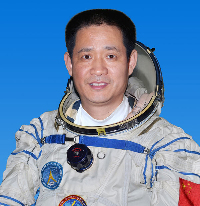Nation's astronauts eager for foreign missions
Updated: 2015-06-01 07:39
By ZHAO LEI(China Daily)
|
||||||||
 |
| File photo of Nie Haisheng. |
China's astronauts are eager to join space flights with foreign counterparts, according to the crew commander of the Shenzhou-10 manned space mission in 2013.
In an exclusive interview broadcast by CNN on Friday, Nie Haisheng also said the country's space station will welcome foreign astronauts.
"As an astronaut, I have a very strong desire to fly space missions with astronauts from other countries. And I look forward to the opportunity to go to the International Space Station," Nie said.
Zhang Xiaoguang and Wang Yaping, crew members of the Shenzhou-10 mission, which lasted 15 days and remains the longest space operation by Chinese astronauts, also shared their personal experiences.
The International Space Station is a joint endeavor by the United States, Russia, Canada, Japan and the European Space Agency. However, due to a US law introduced in 2011, China is barred from participating even though its space officials have repeatedly expressed an interest in it.
The focus of China's space effort is on launching Tiangong-2, the country's second experimental space lab, and preparatory work for the future space station, according to Nie.
China started its manned space program in September 1992 and has launched 10 Shenzhou spacecraft, five of them being manned missions, and the Tiangong-1 space lab.
Yang Liwei, the country's first man in space and now deputy director of the China Manned Space Agency, has told China Daily that China is open to cooperation with other nations in its space station project.
"We reserved a number of platforms that can be used for international cooperation projects inside our future space station when we designed it," Yang said. "In addition to collaboration on applied experiments, we also designed adapters that can dock with other nations' spacecraft."
China is willing to share its knowledge, experience and achievements in space with other countries, especially developing countries, according to Yang. He added that China will also be happy to help train astronauts for other countries and organizations.
By the end of this year, China hopes to have staged the maiden launch of its Long March-6 rocket, which is designed to be a "high-speed response launch vehicle". The Long March-6 will be the latest member of the Long March stable, joining the Long March-7, which will ferry supplies and transport waste from the space station, and China's most powerful rocket, the Long March-5, which will put the station into space. Long March-7 and Long March-5 are set to perform their first missions next year.
If all goes well, China will launch the core module of its space station in 2018 to test technologies and engineering, and the whole station will become fully operational around 2022, according to Wang Zhaoyao, former director of the China Manned Space Agency.
The US National Research Council said in June last year in a report mandated by the US Congress that the ban on NASA-China ties "denies the US partnership with a nation that will probably be capable of making truly significant contributions to international collaborative missions".
- Ballet dancers perform at Zhalong National Nature Reserve in China's Qiqihar
- China destroys 662 kg of illegal ivory
- Mainland Taiwan affairs chief meets political figures from Taiwan
- President Xi demands efforts
to ensure public safety - Half of college students want to work in second-tier cities: Survey
- CPC publishes 'self-decoding' books for Western audience

 Ten injured in crane accident in New York's Midtown Manhattan
Ten injured in crane accident in New York's Midtown Manhattan
 Forum trends: Becoming 'a little more Chinese'
Forum trends: Becoming 'a little more Chinese'
 Giraffe survives for five years with zig-zag neck
Giraffe survives for five years with zig-zag neck
 World's 15 most valuable brands of 2015
World's 15 most valuable brands of 2015
 The world in photos: May 25- 31
The world in photos: May 25- 31
 Solar plane departs from China to Hawaii
Solar plane departs from China to Hawaii
 Modeled on the United States Capitol
Modeled on the United States Capitol
 Highlights of National Children's Wear Design Contest
Highlights of National Children's Wear Design Contest
Most Viewed
Editor's Picks

|

|

|

|

|

|
Today's Top News
China committed to upholding peace, stability in South China Sea
Li's trip a watershed in China-Latin America ties
Kerry delays return to US after injury in bicycle crash
Californians turn to Australia to learn how to fight drought
China issues six-point response to US remark on South China Sea issue
Chinese ambassador warns US against escalating situation in S China Sea
US envoy urges 'unity' over denuclearization of Korean Peninsula
G7 backs inclusion of yuan in IMF basket of currencies
US Weekly

|

|





